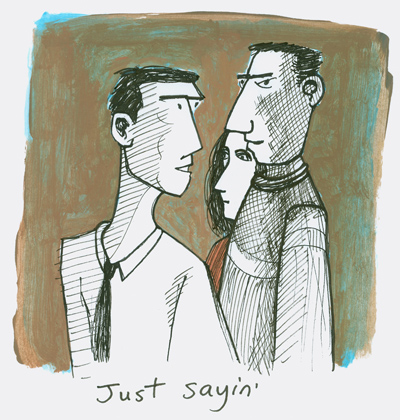 Every Saturday, we’ll be posting a new illustration by David Lester. The Mecca Normal guitarist is visually documenting people, places and events from his band’s 27-year run, with text by vocalist Jean Smith.
Every Saturday, we’ll be posting a new illustration by David Lester. The Mecca Normal guitarist is visually documenting people, places and events from his band’s 27-year run, with text by vocalist Jean Smith.
Nadine stood in the dark behind the house, in the backyard, looking at her parents in the living room. It was after dinner, a time for them to sit and talk or read the paper. The dishes were done and, ostensibly, the children were doing their homework or watching TV; as long as they did it quietly, it didn’t exactly matter to Arnie and Yvette.
It was a consciously beautiful room in an architecturally designed house that incorporated Japanese elements with the Frank Lloyd Wright sensibility of the times. Clerestory windows, rectangular intonations carried over from the Arts and Craft movement of years gone by, when architects had philosophies about humanity at large and how we placed ourselves into a landscape that had yet to be scarred by progress in the form of sub-divided atrocities of repetition.
In matters of design, her parents were virile and vocal purists. The attention they gave to visual details sometimes left Nadine feeling jealous—not quite jealous, but something like it. How could one be jealous of a chair?
Walking home after enduring a day of complex and ever-compounding emotional residue, Nadine felt lightness returning. Once she got home, to her room, with the door closed, she would change out of the clothes she wore to school, putting on hand-me-downs extricated from her brother’s closet by telling him his jeans were too short and that the plaid shirts she coveted didn’t do him any favors.
The twist of pantyhose, the rub at the heel of platform shoes, the abrasive contact of polka dots, black on red, on the short-sleeved polyester jacket with the white lapel that chaffed against her neck and the uncouth fullness of the matching bias cut skirt—an outfit she alone chose to enter high school wearing—all added up to a discomfort that extended immediately beyond her body, to attack specifically, Nadine’s right to freedom of thought.
At home, Nadine wore cowboy boots instead of bedroom slippers, a hip-length suede caramel-colored jacket with a fringe across the back instead of a quilted housecoat and plaid shirts with decorative yokes and pearl snaps. She wore her brother’s old Levi’s, pretending that her father’s now too-tight leather belt had a holster for her imaginary gun. At home, Nadine was a cowboy. The quicker she could lose the female affectations that made her feel more like an alien than a teenage girl, the happier she was.
Nadine stood in the dark on the patio, observing her parents in the living room. She admired Arnie, sitting by the fireplace blowing smoke from his White Owl up the chimney while her mother sat on the couch, wearing her very foolish-looking reading glasses. Nadine snorted quietly as she confirmed to herself that her mother, Yvette, was really only looking at the fashion advertisements in the newspaper spread on the coffee table in front of her. Arnie would, no doubt, be contemplating something too important to share with Yvette, blissfully unable to comprehend the world around her, beyond their indivisibly beautiful, singularly dictatorial home. The house was the vessel that they all floated face down in, unable to measure up, as a population of four, unworthy of living there, sullying its intention to reflect and magnify a quality of occupant that they fell universally short of.






